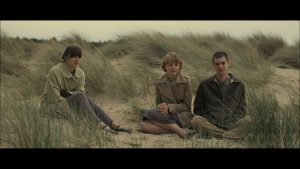Never Let Me Go

Book written by Kazuo Ishiguro (2005)
Film directed by Mark Romanek (2010)
Ishiguro, Romanek, please let us go, you heartless bastards. Not since Chris Lilley killed Pat Mullins (We Can Be Heroes: Finding the Australian of the Year of the Year, ABC TV, 2005) have we at TVC been rendered sleepless by an afflicted fictional character. And we could laugh at Pat. Laugh at any of the characters in Ishiguro’s book or Romanek’s film of the book and you will go straight to hell.
It is best perhaps to watch Romanek’s realisation before reading Ishiguro’s pitiless novel. The film transforms the book for the first time reader in much the same way that Peter Weir’s Picnic at Hanging Rock elevated Joan Lindsay’s book from into something magical and haunting., although the book alone is very fine.
Ishiguro’s story is narrated by Cathy H, who assumes that the reader is a fellow traveller on her life path. So it is not until well into proceedings that the essential fact about her life is revealed. The long and sometimes baffling story of her education at a boarding school known as Hailsham (beautifully evoked in the film as a once grand manor, now somewhat shabby) can puzzle the reader, but builds menace and doubt. The children’s lives are curiously constricted and desolate. Cathy is a conscientious and compassionate reporter who chronicles her peculiar interactions with her friends – the controlling Ruth and thin-skinned Tommy – in minute detail. This opacity is missed in the film, where the fate of the children is made clear at once. Just as the film cannot provide us with the depth of thought of the characters, the book diverges substantially in that two major events happen off stage, but are seen on centre stage in the film (to devastating effect).
The origin of the children is not mentioned until page 137 in the Faber imprint, but rather oddly is not explained at all in the televised version of the film reviewed here (in which a key scene had been cut from the earlier version). Of course the story of a full-length novel must be sped-up and simplified to suit the structure and length of a film, but in any event Romanek captures the essential pity and horror of it with authenticity and imagination.
Carey Mulligan is simply astonishing as the adult Cathy H, her performance a tour de force of dignified acceptance, repression and exhaustion. Keira Knightley is affecting as Ruth, despite the usual Knightley grimacing and chin-acting. Andrew Garfield as Tommy is as damaged, bewildered and alone as he needs to be.
There are obvious flaws in the central idea. While we are asked to accept that in an alternative recent past scientific achievements have outstripped anything thinkable today, we are also expected to believe that we, in that recent past, would look away from hideously immoral concomitant behaviours. We are also tasked to accept that the victims of this cruelty would not attempt to escape it. Although the film makes a passing reference to a form of electronic surveillance, the book suggests that indoctrination from earliest childhood is the cause of this passivity. The reader or viewer will do well however to put these questions aside, favouring pity and terror over credibility.
While Mulligan, Knightley and Garfield are the star performers, (together with the actors who play them as children), Domnhall Gleeson and Andrea Riseborough deserve kudos for their performances as Rodney and Chrissie, housemates of the trio when they leave Hailsham. Their desolation after learning that there are some things even children brought up Hailsham – to them an almost mythical haven – cannot procure is heart-breaking.
Other performers worthy of mention are Charlotte Rampling as Miss Emily, the Hailsham head guardian, and Nathalie Richard as Madame, a patron of the school (whose important scene is the one that has been cut to the film’s depreciation). Rampling gives the ghastly line toward the end of the movie which knocks even the steadfast Cathy. This scene is more gothic and obscure in the book but perhaps the better for its economy in the film. However, we feel that there is a miscasting here. Ishiguro’s Miss Emily is not “especially tall…always very straight with her head right up…She wore her silvery hair tied back, but strands were always coming loose and floating around her….We were all pretty scared of her.” His Madame is “a tall, narrow woman with short hair… with a chilly look” who is in her turn scared of the children. The roles would have been even better reversed.
It is best to go into both of these works with as little fore-knowledge as possible, and we have been careful to avoid spoilers. If you can read the book without weeping, that is perhaps explicable given its slowness and evasion. But if you can watch those two film scenes mentioned above and the final scene of Cathy alone by the roadside amid England’s green beauty and the roadside rubbish, then you have no heart.
Leave a comment...
While your email address is required to post a comment, it will NOT be published.




0 Comments